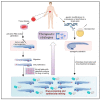Recent Advancement in Breast Cancer Research: Insights from Model Organisms-Mouse Models to Zebrafish
- PMID: 37296923
- PMCID: PMC10252042
- DOI: 10.3390/cancers15112961
Recent Advancement in Breast Cancer Research: Insights from Model Organisms-Mouse Models to Zebrafish
Abstract
Animal models have been utilized for decades to investigate the causes of human diseases and provide platforms for testing novel therapies. Indeed, breakthrough advances in genetically engineered mouse (GEM) models and xenograft transplantation technologies have dramatically benefited in elucidating the mechanisms underlying the pathogenesis of multiple diseases, including cancer. The currently available GEM models have been employed to assess specific genetic changes that underlay many features of carcinogenesis, including variations in tumor cell proliferation, apoptosis, invasion, metastasis, angiogenesis, and drug resistance. In addition, mice models render it easier to locate tumor biomarkers for the recognition, prognosis, and surveillance of cancer progression and recurrence. Furthermore, the patient-derived xenograft (PDX) model, which involves the direct surgical transfer of fresh human tumor samples to immunodeficient mice, has contributed significantly to advancing the field of drug discovery and therapeutics. Here, we provide a synopsis of mouse and zebrafish models used in cancer research as well as an interdisciplinary 'Team Medicine' approach that has not only accelerated our understanding of varied aspects of carcinogenesis but has also been instrumental in developing novel therapeutic strategies.
Keywords: CDX models; GEM models; PDX models; drug screening; mouse; orthotopic models; zebrafish.
Conflict of interest statement
The authors declare no conflict of interest.
Figures



Similar articles
-
Genetically engineered mice as experimental tools to dissect the critical events in breast cancer.Adv Cancer Res. 2014;121:331-382. doi: 10.1016/B978-0-12-800249-0.00008-1. Adv Cancer Res. 2014. PMID: 24889535 Free PMC article. Review.
-
Challenges and Prospects of Patient-Derived Xenografts for Cancer Research.Cancers (Basel). 2023 Aug 31;15(17):4352. doi: 10.3390/cancers15174352. Cancers (Basel). 2023. PMID: 37686627 Free PMC article. Review.
-
Zebrafish patient-derived xenograft models predict lymph node involvement and treatment outcome in non-small cell lung cancer.J Exp Clin Cancer Res. 2022 Feb 9;41(1):58. doi: 10.1186/s13046-022-02280-x. J Exp Clin Cancer Res. 2022. PMID: 35139880 Free PMC article.
-
Patient-derived xenograft mouse models: A high fidelity tool for individualized medicine.Oncol Lett. 2019 Jan;17(1):3-10. doi: 10.3892/ol.2018.9583. Epub 2018 Oct 16. Oncol Lett. 2019. PMID: 30655732 Free PMC article. Review.
-
Establishment of Novel Gastric Cancer Patient-Derived Xenografts and Cell Lines: Pathological Comparison between Primary Tumor, Patient-Derived, and Cell-Line Derived Xenografts.Cells. 2019 Jun 14;8(6):585. doi: 10.3390/cells8060585. Cells. 2019. PMID: 31207870 Free PMC article.
Cited by
-
Exploring the Protective Effect against 7,12-Dimethylbenz[a]anthracene-Induced Breast Tumors of Palmitoylethanolamide.ACS Pharmacol Transl Sci. 2023 Dec 1;7(1):97-109. doi: 10.1021/acsptsci.3c00188. eCollection 2024 Jan 12. ACS Pharmacol Transl Sci. 2023. PMID: 38230286 Free PMC article.
-
Modeling tumor relapse using proliferation tracing and ablation transgenic mouse.NPJ Breast Cancer. 2025 Jul 17;11(1):73. doi: 10.1038/s41523-025-00792-1. NPJ Breast Cancer. 2025. PMID: 40675988 Free PMC article.
-
Steroid hormone receptors, exome sequencing and treatment responsiveness of breast cancer patient-derived xenografts originated in a South American country.Sci Rep. 2025 Jan 18;15(1):2415. doi: 10.1038/s41598-025-86389-x. Sci Rep. 2025. PMID: 39827242 Free PMC article.
-
Advancing breast cancer research: a comprehensive review of in vitro and in vivo experimental models.Med Oncol. 2025 Jul 9;42(8):316. doi: 10.1007/s12032-025-02865-4. Med Oncol. 2025. PMID: 40632186 Review.
-
A Simple, Rapid, and Effective Method for Tumor Xenotransplantation Analysis in Transparent Zebrafish Embryos.J Vis Exp. 2024 Jul 12;(209):10.3791/66164. doi: 10.3791/66164. J Vis Exp. 2024. PMID: 39072643 Free PMC article.
References
-
- Hanahan D. Hallmarks of Cancer: New dimensions. Cancer Discov. 2022;12:31–46. doi: 10.1158/2159-8290.CD-21-1059. - DOI - PubMed
Publication types
Grants and funding
LinkOut - more resources
Full Text Sources
Research Materials

